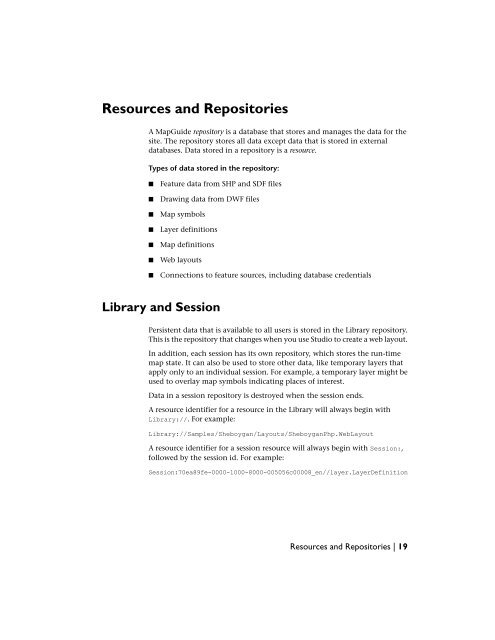Developer's Guide - MapGuide Open Source - OSGeo
Developer's Guide - MapGuide Open Source - OSGeo
Developer's Guide - MapGuide Open Source - OSGeo
Create successful ePaper yourself
Turn your PDF publications into a flip-book with our unique Google optimized e-Paper software.
Resources and Repositories<br />
A Map<strong>Guide</strong> repository is a database that stores and manages the data for the<br />
site. The repository stores all data except data that is stored in external<br />
databases. Data stored in a repository is a resource.<br />
Types of data stored in the repository:<br />
■ Feature data from SHP and SDF files<br />
■ Drawing data from DWF files<br />
■ Map symbols<br />
■ Layer definitions<br />
■ Map definitions<br />
■ Web layouts<br />
■ Connections to feature sources, including database credentials<br />
Library and Session<br />
Persistent data that is available to all users is stored in the Library repository.<br />
This is the repository that changes when you use Studio to create a web layout.<br />
In addition, each session has its own repository, which stores the run-time<br />
map state. It can also be used to store other data, like temporary layers that<br />
apply only to an individual session. For example, a temporary layer might be<br />
used to overlay map symbols indicating places of interest.<br />
Data in a session repository is destroyed when the session ends.<br />
A resource identifier for a resource in the Library will always begin with<br />
Library://. For example:<br />
Library://Samples/Sheboygan/Layouts/SheboyganPhp.WebLayout<br />
A resource identifier for a session resource will always begin with Session:,<br />
followed by the session id. For example:<br />
Session:70ea89fe-0000-1000-8000-005056c00008_en//layer.LayerDefinition<br />
Resources and Repositories | 19


